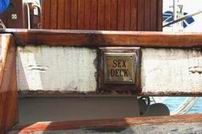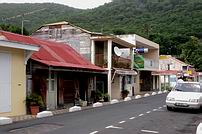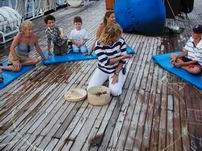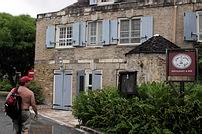The Tall Ship, Polynesia
CRUISING THE LEEWARD ISLANDS - JULY 2006
From FortOgden.com
|

The images on this page are "Thumbnails". Click on the picture to view the larger version.
We booked our flight to Antigua through Windjammer's FareShare program at a cost considerably less than we could have found on our own. We flew Delta from LAX to Antigua with
 a short layover in Atlanta. When my grandson and I boarded the Polynesia in St. Johns it was the third Sunday in July and the beginning of "Carnival Week" in Antigua. a short layover in Atlanta. When my grandson and I boarded the Polynesia in St. Johns it was the third Sunday in July and the beginning of "Carnival Week" in Antigua.
Polynesia is a 250' four-masted fisherman-rigged schooner. She has a crew of 45 and berths for 112 passengers. The "Poly" was acquired by Windjammer in 1975. Originally constructed in 1938, she was one of the last of the Portuguese Grand Banks Fishing Fleet. As the schooner Argus, she was featured in National Geographic and was the subject of Allen Villers book, "The Quest of the Schooner Argus". The original ship's bell still hangs on the main deck.  Our cruise was to include stops at Guadeloupe, Dominica, Isles des Saintes, Nevis and Falmouth Harbor. But, when on a sailing ship with a relatively small auxiliary engine it's fair to expect some itinerary changes when a great deal depends on the whims of the sea and the wind.
Our cruise was to include stops at Guadeloupe, Dominica, Isles des Saintes, Nevis and Falmouth Harbor. But, when on a sailing ship with a relatively small auxiliary engine it's fair to expect some itinerary changes when a great deal depends on the whims of the sea and the wind.We departed the harbor at St. Johns early Monday morning. When we were clear of the breakwater and with a fair wind, the sails were hoisted to the bagpipe strains of "Amazing Grace". This never fails to bring on an emotional pang, even to the saltiest jammer.  The Captain was none other than the legendary Neil Carmichael who was back with Windjammer, at least for a while. Capt. Neil is know for his bawdy language and humor, but on this voyage he was uncharacteristically subdued. Perhaps this was due to the fact that onboard were his wife and children as well as Captain Stuart, the head of Windjammer fleet operations.
The Captain was none other than the legendary Neil Carmichael who was back with Windjammer, at least for a while. Capt. Neil is know for his bawdy language and humor, but on this voyage he was uncharacteristically subdued. Perhaps this was due to the fact that onboard were his wife and children as well as Captain Stuart, the head of Windjammer fleet operations.From Antigua we set a course south to the Island of Guadeloupe. At about 4:00 PM, we came under the lee of Guadeloupe and shortly after, the Polynesia dropped her anchor in  the Bay of Deshaies, a natural harbor on the northwest coast of the island. Captain Neil ordered out the diving plank and the young and courageous proceeded to jump into the warm clear Caribbean. The more courageous jumped or dove from the the jib boom or the widows' net which is the equivalent of going off a six meter diving platform.
the Bay of Deshaies, a natural harbor on the northwest coast of the island. Captain Neil ordered out the diving plank and the young and courageous proceeded to jump into the warm clear Caribbean. The more courageous jumped or dove from the the jib boom or the widows' net which is the equivalent of going off a six meter diving platform.
The Poly remained in the bay through dinner and passengers stayed on board and did not go ashore to the village of Deshaies.  About 8:30 PM the anchor was up and the Polynesia headed farther south to our next port of call in Dominica. By breakfast time on day 2 we were finding our anchorage about two miles beyond Roseau near a commercial landing where scuba and snorkel boats are based. From there we chose a friendly van driver named David for a two hour tour of the rain forest. Dominica is a volcanic island with mountains nearly 5000' up into the clouds. Somewhere near the top we we hiked a quarter of a mile to Trafalgar Falls, a spectacular waterfall in a spectacular setting.
About 8:30 PM the anchor was up and the Polynesia headed farther south to our next port of call in Dominica. By breakfast time on day 2 we were finding our anchorage about two miles beyond Roseau near a commercial landing where scuba and snorkel boats are based. From there we chose a friendly van driver named David for a two hour tour of the rain forest. Dominica is a volcanic island with mountains nearly 5000' up into the clouds. Somewhere near the top we we hiked a quarter of a mile to Trafalgar Falls, a spectacular waterfall in a spectacular setting. Later in the afternoon we signed on for a snorkel trip on a well equipped catamaran that took us to a spot called "Champagne Reef" where, in 5 to 10 foot depth, hot water and bubbles filter out of ocean vents. This attracts a variety of marine life. Octopus, squid, parrot fish and others swim about the coral and sponges. Since the time I was last here, seven years ago, Dominica's economic growth has been remarkable. It has has embraced eco-tourism and become a destination island. Now there is even a Carnival cruise ship that calls once a week. That night was the PPP Party. Passengers and crew dress as Pirates, Pimps or Prostitutes then prance and party on the "Sex Deck". This is not as sinful as it sounds. Prizes are awarded for the best costumes and everyone has a great time including the 25 or so "Junior Jammers" passengers who were between the ages of 7 and 16. 



 That night we sailed back north to our next destination, Isles des Saintes. Les Isles des Saintes are a group of small French islands a few miles from Guadeloupe. We dropped our anchor in the picturesque harbor of the largest island in the group, Terre-de-Haut.
"Les Isles" were first populated by Norman and Breton fishermen in the mid 1600's and their descendents are today known as the best fishermen in the Caribbean.
That night we sailed back north to our next destination, Isles des Saintes. Les Isles des Saintes are a group of small French islands a few miles from Guadeloupe. We dropped our anchor in the picturesque harbor of the largest island in the group, Terre-de-Haut.
"Les Isles" were first populated by Norman and Breton fishermen in the mid 1600's and their descendents are today known as the best fishermen in the Caribbean.
The island caters to day-tripping tourists from Guadeloupe and has a number of fine restaurants, shops, art galleries and historical sites. One such site is Fort Napoleon, located on the heights above the village and provides wonderful views of the island and bay. 



Before we sailed away from the Saintes, Captain Neil informed us of a tropical storm which was coming from the Atlantic and would affect our itinerary. Instead of going to Nevis we would head back to Guadeloupe and wait out the weather in the Bay of Deshaies where we had been previously. This was somewhat disappointing, but this is a reality of sailing. So after an uneventful night sail, a great breakfast and an informative captain's story time, the passengers were free to board the ship's tenders and go ashore to the village of Deshaies. The village with a population of about 3,000 is typical French Caribbean, with interesting shops and restaurants. The streets are clean and well marked. A number of small hotels on the outskirts of the town cater to the French tourists who flock to Guadeloupe. We found no English spoken here, so our tourist experience in Deshaies was limited to just looking. 


 That night we sailed north to Antigua and Falmouth Harbor through the Guadeloupe Passage a 40 mile stretch of sea unprotected from the eastern wind and waves. There was a bit of rocking and rolling, but this old ship was designed as a commercial fishing ship and meant to handle the worst the North Atlantic could give. 



 In the morning when we arrived in Falmouth Harbor it had stopped raining (momentarily). We were in the first tender ashore. It's a ten minute tender ride to the dock from where we had anchored. The water in the outer harbor was choppy and then it rained again. Between the sea water and the rain everyone in the boat was drenched thoroughly.
In the morning when we arrived in Falmouth Harbor it had stopped raining (momentarily). We were in the first tender ashore. It's a ten minute tender ride to the dock from where we had anchored. The water in the outer harbor was choppy and then it rained again. Between the sea water and the rain everyone in the boat was drenched thoroughly.
 Once ashore (it had stopped raining) we walked the short distance to English Harbor and Nelson's Dockyard. It was a base for the British Navy and served as the headquarters of the Leeward Islands Fleet during the French wars of the late 18th century. it was abandoned during the nineteenth century and was closed in 1889. Today Nelson's Dockyard has been completely restored as a national park.
Once ashore (it had stopped raining) we walked the short distance to English Harbor and Nelson's Dockyard. It was a base for the British Navy and served as the headquarters of the Leeward Islands Fleet during the French wars of the late 18th century. it was abandoned during the nineteenth century and was closed in 1889. Today Nelson's Dockyard has been completely restored as a national park.
 We found a van to take us to Shirley Heights, which is the hill that overlooks English Harbor. It has a commanding view and was fortified to defend the harbor. It too is part of the Antigua-Barbuda National Park system and is the site for an organized Jazz and "Jump Up" music festival each Sunday at 3:00PM.
We found a van to take us to Shirley Heights, which is the hill that overlooks English Harbor. It has a commanding view and was fortified to defend the harbor. It too is part of the Antigua-Barbuda National Park system and is the site for an organized Jazz and "Jump Up" music festival each Sunday at 3:00PM.
We returned to the ship knowing that this would be the last night of the cruise. Passengers were packing and settling their ship accounts in preparation for their flights home. Tonight was also the Captain's Dinner. The cooks and stewards outdid themselves. The food and service was outstanding. Around midnight we upped anchor and sailed the few miles to the other side of the island for the dock at Saint Johns. When our flight arrangements were made through Windjammer's FareShare program, they were unable to make return arrangements on Saturday so Windjammer graciously allowed us to stay aboard the Polynesia as stowaways until our flight on Sunday. This was fortunate for us because an Antigua Carnival parade would be going strong all afternoon Saturday and into the night. 


EPILOGUE 
CLICK HERE TO SEE THE POLYNESIA CRUISE SLIDES WITH DOZENS MORE PICTURES
FortOgden.com has no financial or administrative connection to any cruise line or travel agency.

This page was last updated on
© 2006 ~ 2008, FortOgden Design, Huntington Beach, CA
|